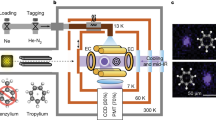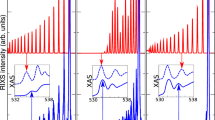Abstract
RECENT developments in the theory of band spectra in the infra-red1 lend particular interest to all new experimental results for triatomic molecules. We have recently examined the absorption spectrum of carbonyl sulphide, making use of a monochromator method in order to avoid the photochemical decomposition to be expected on exposure of this substance to the full energy of a Nernst filament. We find a complicated spectrum—a fact which in itself demonstrates the lack of symmetry in the molecule: the results are summarised in Fig. 1. In the few cases in which the bands have been resolved, the separation between the P and R branches is given.
This is a preview of subscription content, access via your institution
Access options
Subscribe to this journal
Receive 51 print issues and online access
$199.00 per year
only $3.90 per issue
Buy this article
- Purchase on Springer Link
- Instant access to full article PDF
Prices may be subject to local taxes which are calculated during checkout
Similar content being viewed by others
References
Dennison, Reviews of Modern Physics, vol. 3, p. 280; 1931.
Zeit. Krist., vol. 77, p. 411; 1931.
Author information
Authors and Affiliations
Rights and permissions
About this article
Cite this article
BAILEY, C., CASSIE, A. Infra-Red Absorption Spectrum of Carbonyl Sulphide. Nature 128, 637–638 (1931). https://doi.org/10.1038/128637c0
Issue Date:
DOI: https://doi.org/10.1038/128637c0
Comments
By submitting a comment you agree to abide by our Terms and Community Guidelines. If you find something abusive or that does not comply with our terms or guidelines please flag it as inappropriate.



